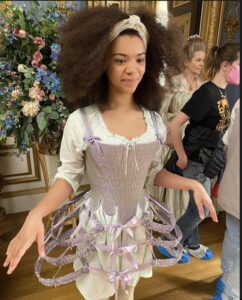
Introduction: Unveiling the Royal Truth Behind Queen Charlotte’s Story
Netflix’s Queen Charlotte: A Bridgerton Story has captivated audiences worldwide with its stunning portrayal of the beloved royal character, Queen Charlotte. This prequel to the Bridgerton series takes a deep dive into Charlotte’s life and reign, blending romance, power struggles, and drama. But how much of what we see on screen reflects the reality of Queen Charlotte’s actual life?

In this article, we’ll explore the significant differences and surprising similarities between the portrayal of Queen Charlotte in Netflix’s Queen Charlotte and the true events of her life. Whether you’re a Bridgerton fan, a history buff, or both, understanding the real story behind the queen’s life will provide fascinating insights into the blend of fiction and fact that makes the series so intriguing.
H1: Who Was Queen Charlotte? A Historical Overview
Before comparing the Netflix portrayal to reality, let’s take a moment to learn about the real Queen Charlotte.
H2: Queen Charlotte in Real Life: The True Story
Charlotte of Mecklenburg-Strelitz was born in 1744 in Germany and became Queen Consort of Great Britain and Ireland after marrying King George III in 1761. Her life was filled with both personal and political challenges, as she had to navigate the complexities of being the wife of a king who struggled with mental health issues.
While the show romanticizes many elements of her character, including her relationship with King George III, the historical Charlotte was known for her intelligence, strength, and devotion to her family and country.
H2: What Netflix’s Queen Charlotte Gets Right
H3: Queen Charlotte’s Early Life and Marriage to King George III
One of the most accurate aspects of Netflix’s Queen Charlotte is how it depicts her marriage to King George III. The series follows the historical truth that Charlotte was chosen to marry George, with little romantic entanglement beforehand. Their marriage, though initially one of political necessity, did evolve into a deep emotional bond. The series shows this gradual transition, showcasing their connection as more than just a royal duty.

In reality, Charlotte was the daughter of Duke Charles Louis Frederick of Mecklenburg-Strelitz and Princess Elizabeth Albertina of Saxe-Hildburghausen. Her marriage to George was arranged through the influence of politicians, but it soon blossomed into a partnership based on love, affection, and shared challenges, particularly George’s mental health.
H3: Queen Charlotte’s Influence on Society
While much of the drama surrounding Queen Charlotte’s social influence is fictionalized, there is truth in her powerful role within the British court. The show highlights her patronage of the arts, her forward-thinking views on education, and her role in shaping the cultural landscape. In real life, Queen Charlotte was indeed a major patron of the arts, founding the Queen’s House at Kew Gardens and supporting musicians, artists, and architects during her time as consort.
H3: The Depiction of Charlotte’s Relationship with King George III
While Queen Charlotte on Netflix dramatizes the emotional complexities of the relationship between Charlotte and King George III, it’s grounded in truth. King George was indeed a deeply troubled man, suffering from what historians believe may have been bipolar disorder, a condition that significantly affected their marriage. The show does a commendable job of portraying the genuine emotional struggles Charlotte endured as she cared for her husband, balancing her duties as queen with her role as a wife.
H2: What Netflix’s Queen Charlotte Gets Wrong
H3: The Fictionalized Youthful Love Story
While the show paints a beautiful and passionate love story between Charlotte and George, the reality wasn’t as idyllic. Charlotte was a young princess thrust into an arranged marriage, and although she did come to love George, it wasn’t immediately as romantic as portrayed. The show’s dramatized first meeting and instant connection is a romanticized version of the real event, where Charlotte was mostly adjusting to royal life and her new position.
In the series, we see a whirlwind romance, but in reality, Charlotte’s feelings toward George grew over time. Their marriage started with practicality and was only later strengthened by emotional and intellectual companionship.
H3: The Dramatic Portrayal of Queen Charlotte’s Political Role
While Queen Charlotte had a significant role in court affairs, Netflix’s Queen Charlotte goes beyond what history tells us about her influence in politics. In the show, she is often depicted as a more hands-on and politically active character than what records suggest. Charlotte did have a strong voice in matters concerning her family and the welfare of the country, but her political involvement was far more indirect compared to the fictionalized, power-driven queen seen in the series.
H3: Queen Charlotte’s Age and Appearance
Netflix’s portrayal of Queen Charlotte is often youthful and vibrant, with India Amarteifio playing a young Charlotte who is full of life. Historically, Queen Charlotte was around 17 years old when she married George, but she was often described as less traditionally beautiful than her portrayal on screen. Historians note that Charlotte had an unconventional appearance for a queen, with a broad nose and a unique charm that was more about her character than her beauty.
H1: The Realities of Mental Health in the Royal Family
One of the most significant aspects of Queen Charlotte: A Bridgerton Story is the portrayal of King George III’s mental health struggles. While the series introduces his condition with some creative liberties, it’s based on real events.
H2: King George III’s Mental Health Struggles
In real life, King George III’s mental health issues were well-documented. He suffered from episodes of mania and depression, often leaving him incapacitated for long periods. Queen Charlotte portrays this aspect of George’s life with surprising accuracy, showing how Charlotte tried to manage his condition while still fulfilling her royal duties.
However, the exact nature of George’s illness is still a matter of historical debate. Some believe he had bipolar disorder, while others think he may have had porphyria, a rare blood disorder. Netflix’s dramatization gives audiences a look into these struggles, but some of the more sensationalized aspects—like the specific nature of his condition—are speculative.
H2: The Legacy of Queen Charlotte and Her Impact on Bridgerton
Despite the fictionalized elements in Queen Charlotte, the show has also had a significant impact on how we view historical royal figures, especially in the context of the Bridgerton universe. Queen Charlotte’s portrayal in the Netflix series blends history with drama, creating a character who feels both grounded in reality and larger-than-life. For Bridgerton fans, her story is crucial for understanding the deep connections that influence the events of the main series.
H3: The Connection Between Queen Charlotte and Bridgerton’s Storyline
As the matriarch of the ton in the Bridgerton series, Queen Charlotte’s story in the prequel provides essential background for the social and political dynamics at play in the Bridgerton family’s world. The show’s focus on her growth as a leader and royal figure sets the stage for her authoritative role in the main Bridgerton series.
H1: Conclusion: Netflix’s Queen Charlotte – A Historical Drama with Real-Life Roots
While Queen Charlotte: A Bridgerton Story takes creative liberties with the facts, the show does manage to stay grounded in the essence of the real Queen Charlotte’s life. The series blends romance, power, and history in a way that’s captivating for audiences, even if it occasionally departs from historical accuracy.
Whether you’re a fan of the Bridgerton universe or a history enthusiast, the differences and similarities between the Netflix portrayal and real-life events offer a fascinating glimpse into the life of a queen who left a lasting legacy in both royal history and popular culture.
